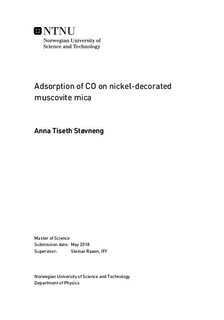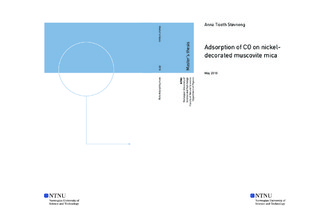| dc.description.abstract | Adsorption of carbon monoxide on nickel-decorated muscovite mica is studied using the surface analysis techniques X-ray photoelectron spectrocsopy, temperature programmed desorption, and atomic force microscopy.
Muscovite mica is a clay mineral that forms large crystalline flakes and is therefore well suited for surface analysis studies. The mica samples are decorated with various amounts of nickel, making a system that can serve as a model for various catalytic processes. Carbon monoxide is known not to adsorb on clean mica surfaces, but adsorbs readily when nickel is evaporated onto the mica surface.
Three main desorption peaks for carbon monoxide are found, around 250-280 K, 350-420 K and 550-600 K. The number of peaks, and their intensities depend on the amount of nickel deposited on the mica surface, and on the way the samples are prepared. Kinetic desorption parameters are found for the different samples, with desorption energies ranging from 0.1 to 1.25 eV depending on nickel amount and CO coverage. The corresponding pre-exponential factors are found in a range from 1 to 10^(8.5) s^(-1), indicating that the CO desorption is not of first order for any of the samples.
The results show that the sample preparation procedure is of importance for CO adsorption, especially the annealing procedure. Mica surfaces annealed at 700 K overnight, prior to Ni and CO exposures at substrate temperatures of 150 K were found to adsorb the largest amounts of CO.
XPS measurements show some evidence of CO decomposition on our samples. A small increase in the carbon peak is found for some of the samples after CO adsorption and desorption. Comparing this to earlier studies, this carbon might desorb if the surfaces are exposed to oxygen prior to desorption, at temperatures around 620 K and 820 K. | |

